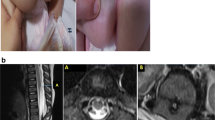Abstract
Introduction
The causes of tethered spinal cord are various. In order to release the tethering effect of these malformations, the surgical interventions must include removal of all tethering components, reconstruction of the neural tube and sectioning of tight filum terminale as well.
Cases
The cases reported in this paper have had an operation many years before for various developmental defects. After a certain period of time (5–10 years) of the first operation, the patients reapplied to the hospital with various symptoms of spinal cord tethering, either vertical or horizontal.
Discussion
At surgical intervention, it was noted that inappropriate surgical procedures caused retethering of the spinal cord in all patients. Postoperative period of all patients were uneventful. All patients declared relief in their symptoms. We would like to draw attention that untreated (or inappropriately treated) midline developmental defects will invariably cause syndrome of tethered cord. Consequently, prophylactic surgical untethering must be applied to all patients with developmental midline defects as soon as possible.
Conclusion
It looks that tethered cord symptoms invariably appear as enough negative influence accumulates as the time passes. Elapsed time may vary but unpleasant end result invariably arrives. While these cases with tethered spinal cord develop progressive neurological symptoms, prophylactic and appropriate surgical intervention should be considered as early as possible. There is no acceptable rationale to wait for the appearance of tethered cord syndrome symptoms to perform surgical untethering of the spinal cord because of the probability of irreversibility of the symptoms (incontinence of urine in particular) of tethered spinal cord syndrome.




Similar content being viewed by others
References
Şahin F, Selçuki M, Zenciroğlu A, Ünlü A, Yılmaz F, Maviş N, Sarıbaş S (1997) Level of conus medullaris in term and preterm neonates. Fetal Neonatal 77(1):67–69
Yamada S, Zinke DE, Sanders D (1981) Pathophysiology of tethered cord syndrome. J Neurosurg 54:494–503
Koyanagi I, Iwasaki Y, Hida K, Abe H, Isu T, Akino M (1997) Surgical treatment supposed natural history of the tethered cord with occult spinal dysraphism. Child's Nerv Syst 13:268–274
Phuong LK, Schoeberl KA, Raffel C (2002) Natural history of tethered cord in patients with meningomyelocele. Neurosurgery 50(5):989–995
Tarcan T, Onol FF, Ilker Y, Alpay H, Simşek F, Ozek M (2006) The timing of primary neurosurgical repair significantly affects neurogenic bladder prognosis in children with myelomeningocele. J Urol 176(3):1161–1165
Yong RL, Bach-Habrock T, Vaughan M, Kestle JR, Steinbok P (2011) Symptomatic retethering of the spinal cord after section of a filum terminale. Neurosurgery 68(6):1594–1602
Ogiwara H, Lyszczarz A, Alden TD, Bowman RM, McLOne DG, Tomita T (2011) Retethering of transected fatty filum terminales. J Neurosurg Pediatr 7(1):42–46
Author information
Authors and Affiliations
Corresponding author
Rights and permissions
About this article
Cite this article
Selçuki, M., Umur, A.Ş., Duransoy, Y.K. et al. Inappropriate surgical interventions for midline fusion defects cause secondary tethered cord symptoms: implications for natural history report of four cases. Childs Nerv Syst 28, 1755–1760 (2012). https://doi.org/10.1007/s00381-012-1713-0
Received:
Accepted:
Published:
Issue Date:
DOI: https://doi.org/10.1007/s00381-012-1713-0




